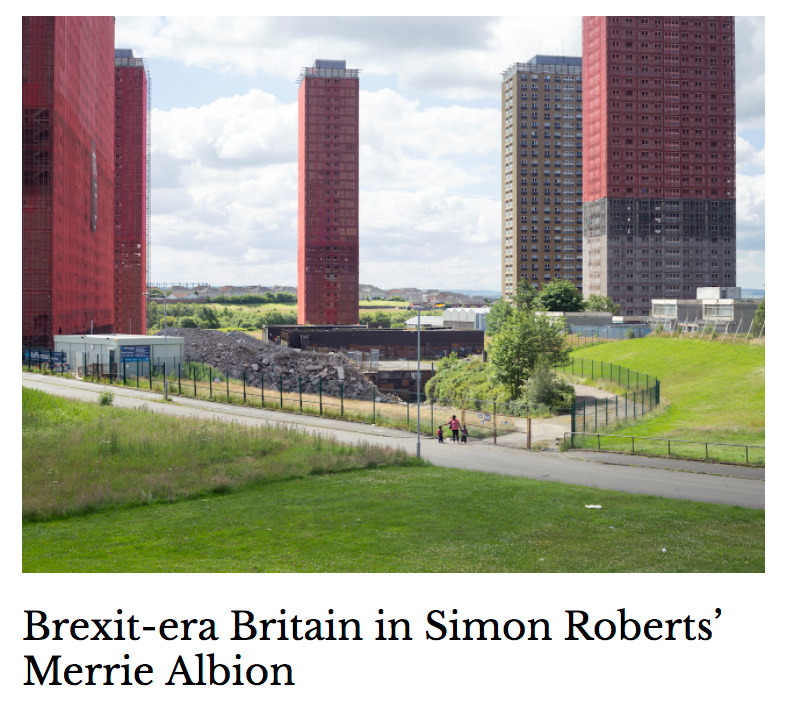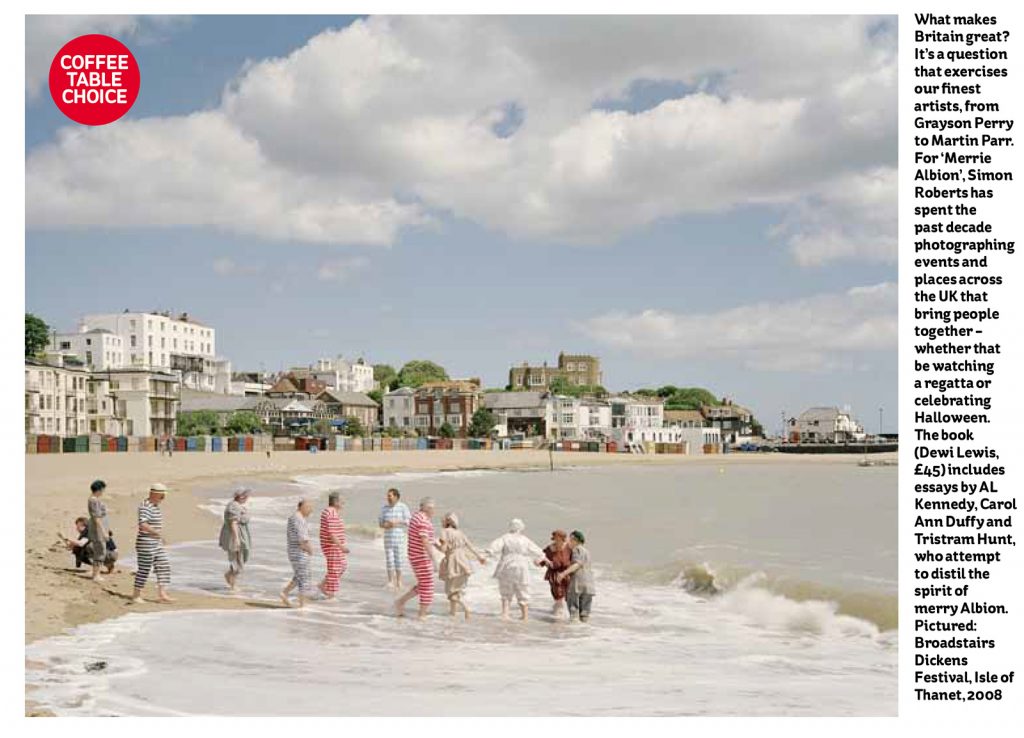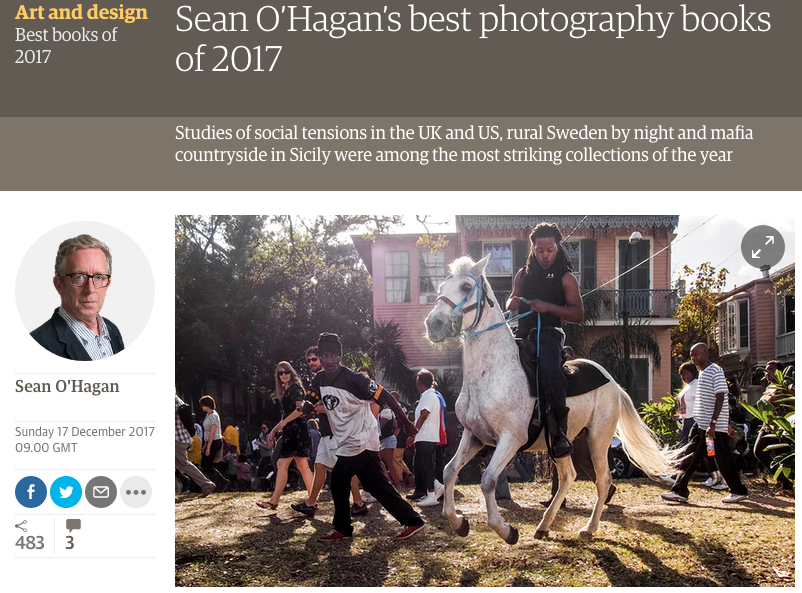
Reviews of Merrie Albion
Merrie Albion was recently featured as the ‘Coffee Table Book’ of the week by The Independent newspaper (below) and also made Sean O’Hagan’s Top Photobooks list of 2017 in The Observer and Tim Clark’s round-up of Top 10 photobooks list on 1000 Words.


Sean O’Hagan writes:
“Anyone looking for a Christmas present for their Brexiter dad or Remainer mum should seek out Simon Roberts’s big and beautifully designed Merrie Albion: Landscape Studies of a Small Island (Dewi Lewis £45). A portrait of contemporary Britain, it presents the nation in all its complexity, from city traders to Muslim worshippers, while somehow evincing a sense of place that is palpable and oddly reassuring. Shot on a medium format camera, often from an elevated point of view, Roberts sometimes makes composites of the same scene, creating images that have the theatricality of one of his inspirations, William Powell Frith, the 19th-century painter of everyday English tableaux. A book that speaks quietly and powerfully about this increasingly disunited kingdom at a pivotal moment.”
Kitty Grady in the Financial Times writes:
“A visual chronicler, Simon Roberts’ scenes of public gatherings conflate traditional landscape painting with social documentary. His latest exhibition, featuring photos taken during the past 10 years, focuses on events and places that define recent British history, such as student protests, Grenfell Tower and Shoreham Air Show.
In his Brueghel-like compositions of congregation, carnival and revolt, Roberts resists simplistic notions of nationhood. His landscapes, woven with juxtapositions, tensions and ironies, show the fracture of contemporary society.”
Other reviews include this one by Michael Grieve in the BJP –
“Merrie Albion: Landscape Studies of a Small Island is a concise compendium of Britain over the past few years and is an excellent visual survey of the run-up to Brexit. The photographs examine rich and complex variations of Britain that are now even more poignant after last year’s vote. Images of election campaigning in clean and tidy suburbia, protests, the aftermath of riots in London, diamond jubilee celebrations, rock concerts, a family enjoying Brighton beach, computer screens of the trading floor of Lloyds – the list goes on. Roberts has managed to capture all the major events in juxtaposition with minor situations that are large with meaning, from the dead of the Iraq war being saluted by Army veterans through Wootton Bassett to a depiction of impoverished mothers and children at a youth club in Blackburn. Contained within each photograph are mini dramas, cheap-looking high streets with pound shops set against Victorian architecture. Roberts shows a Britain at odds with itself. Rather than a harmonious society, we sense fragmentation and awkwardness and a yearning for a glorious past that never existed.”
Adrian Burnham in The New European writes:
“Roberts’ work celebrates the ebb and flow of group activity by which our society seems to breathe. Except, for me, there’s a choking feeling too. Be it airshow, music festival, countryside event, protest or civic assembly. At one level these denotations of culture afford ideas of positive collectivity in the face of the supposed social disintegration commonly associated with our ever more digital age.
This isn’t socio-economic concern tacked onto a creative visual practice. Roberts studied human geography prior to becoming a photographer and a more and less obvious but always deep concern with the state and fate of people appearing in his work endures.”
In Town and Country, Frances Hedges writes:
Roberts’ scenes range from the joyful – a festival on a Kentish beach, a Diamond Jubilee street party on an estate, Eid al-Fitr celebrations – to the poignant, such as an image of Grenfell Tower in the wake of last summer’s tragic fire. He is interested in the drama that is inherent in certain social customs, religious practices or community rituals, where humans become characters within shared stories. He brings the eye of a documentary photographer to the genre of landscape art, highlighting the complexities of our relationships with both people and our lived environment. At a time when the question of British identity is at the forefront of our national conversations, Roberts’ works paint a challenging picture of a country whose differences are as much a cause for celebration as the characteristics its people have in common.
There’s this one from Rebecca Fulleylove on It’s Nice That:
“This body of work serves as a reminder that the landscapes and environments we live in are shaped by the people that inhabit them. Simon not only provides a survey of Britain’s public spaces but also offers commentary and a topical look at what’s happened in Britain over the last ten years.”
Over on 1000 Words, Tim Clark writes:
“More conventional in format but relying on utterly captivating landscape photography is Simon Roberts’ Merrie Albion: Landscape Studies From A Small Island. Released in the wake of the nationalist triumph of Brexit, this brilliant new book takes the temperature of the UK, offering insights most necessary into notions of identity and belonging and, specifically, what it means to be British at this significant moment in contemporary history. With his customary elevated perspective and tableaux style, we oversee views of places and the people that populate them to form a survey: not only of spaces used for leisure and cultural activity but also subjects and events that can now be viewed as defining locations in recent times, such as the London 2012 Opening Ceremony or Grenfell Tower. A real socio-political mood piece, the power and urgency of which reminds us why Roberts is regarded as one of the leading UK photographers working today.”
Meanwhile, Peggy Roalf includes the book in her feature Top Photo Books for the Holidays for Design Art Daily:
“The photographs examine rich and complex variations of Britain that are now even more poignant after last year’s vote. Images of election campaigning in clean and tidy suburbia, protests, the aftermath of riots in London, diamond jubilee celebrations, rock concerts, a family enjoying Brighton beach, computer screens of the trading floor of Lloyds – the list goes on.
Roberts has managed to capture all the major events in juxtaposition with minor situations that are large with meaning, from the dead of the Iraq war being saluted by Army veterans through Wootton Bassett to an depiction of impoverished mothers and children at a youth club in Blackburn. Contained within each photograph are mini dramas, cheap-looking high streets with pound shops set against Victorian architecture. Roberts shows a Britain at odds with itself.”
And finally this one by Simon Bowcock on Photomonitor:
“Simon Roberts’s aloof and detached approach may be the antithesis of Wood’s, but his new book Merrie Albion is nonetheless full of engaging pictures which reward time spent. Redolent of classic English landscape paintings with their slightly elevated viewpoints and people scattered in the middle-distance (think Constable), they also carry a very contemporary air of detachment and a level of societal detail which invites repeated viewings.”